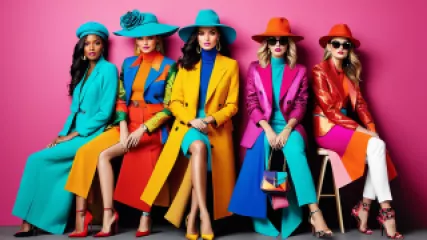The Ultimate Guide to Understanding the Psychology of Fashion
The Ultimate Guide to Understanding the Psychology of Fashion
Have you ever wondered why certain clothes make you feel more confident or why you find yourself drawn to specific colors and styles? The answer lies in the fascinating field of psychology of fashion. This article will take you on a deep dive into the intricate relationship between fashion and the human mind, exploring how our clothing choices can impact our mental health and emotional well-being. Whether you're a fashion enthusiast or simply curious about the power of style, this ultimate guide will provide you with valuable insights and practical tips for harnessing the therapeutic potential of fashion.
Section 1: The Psychology Behind Fashion Choices
Fashion is more than just fabric and trends; it is an expression of our identities, beliefs, and emotions. Our clothing choices reflect our personality, values, and aspirations, making them a powerful tool for self-expression. Psychologists have long studied the psychological aspects of fashion and have identified several key factors that influence our fashion choices.
One of the primary influences on our fashion choices is self-perception. What we wear can shape how we see ourselves and how others perceive us. Research has shown that clothing can affect our mood, confidence levels, and even cognitive abilities. When we dress in a way that aligns with our self-image, we experience a sense of authenticity and empowerment.
Additionally, societal norms and cultural influences play a significant role in shaping our fashion choices. We often conform to certain dress codes or adopt specific styles to fit in or communicate belonging to a particular social group. Fashion is a way to signal our affiliation with a particular subculture, social class, or ideological community.
Another important factor in fashion choices is emotional state. Our emotions can greatly impact the colors, patterns, and styles we are drawn to. For example, during periods of stress or sadness, we may opt for comfortable and familiar clothing, while in times of joy or excitement, we may be more inclined to experiment with bold and vibrant looks.
Section 2: Fashion as Therapy
In recent years, the concept of fashion as therapy has gained significant attention within the field of mental health. Fashion has the potential to positively impact our emotional well-being, providing a form of self-care and self-expression. Let's explore some ways in which fashion can contribute to our mental health:
1. Self-Expression and Identity
Our clothing choices allow us to express ourselves and communicate our values and identities to the world. By dressing in a way that feels authentic, we can enhance our self-esteem and cultivate a sense of belonging.
"Fashion is a language that creates itself in clothes to interpret reality."
- Karl Lagerfeld
2. Mood Enhancement
The colors and textures of our clothes have the power to influence our mood. Wearing vibrant colors or soft fabrics can uplift our spirits and boost our confidence, while soothing tones and cozy materials can provide comfort during times of stress.
3. Empowerment and Confidence
Choosing outfits that make us feel confident can significantly impact our self-assurance and how we interact with others. The right combination of clothing and accessories can empower us to face challenges and seize opportunities.
4. Emotional Healing
Engaging in wardrobe therapy can be a transformative experience for those navigating emotional challenges. By carefully curating their wardrobes, individuals can create a safe space for emotional healing and self-discovery.
Section 3: Fashion Choices and Mental Health
Our fashion choices have a profound impact on our mental health and overall well-being. They can either support or hinder our emotional state, depending on various factors. Understanding this relationship allows us to make intentional choices that promote positive mental health:
1. Dressing for Success
Research has consistently shown that what we wear can influence our performance and success in various areas of life. Dressing professionally or in a manner appropriate for the task at hand can boost our confidence and competence, leading to increased productivity and achievement.
2. Body Image and Self-Acceptance
The fashion industry has often been criticized for promoting unrealistic beauty standards, which can negatively impact body image and self-esteem. However, embracing diverse representations of beauty and choosing clothes that make us feel comfortable and confident can promote self-acceptance and body positivity.
3. Emotional Triggers
Certain clothes or accessories may hold emotional significance, reminding us of past experiences or triggering specific emotions. Being mindful of these triggers allows us to make informed choices about what to wear in different situations, ensuring our emotional well-being is prioritized.
4. Mindful Consumption
The fast-paced nature of the fashion industry can contribute to feelings of stress, guilt, and dissatisfaction with our own wardrobe. Practicing mindful consumption involves making conscious decisions about purchasing and caring for clothing, prioritizing quality over quantity, and supporting sustainable and ethical fashion practices.
Section 4: Fashion and Emotional Healing
For many individuals, fashion serves as a powerful tool for emotional healing and personal growth. By consciously selecting clothing that resonates with their emotions and values, they embark on a journey of self-discovery and transformation. Here are some ways in which fashion can facilitate emotional healing:
1. Rituals of Self-Care
Engaging in fashion-related rituals, such as selecting outfits mindfully or organizing your wardrobe, can provide a sense of control, comfort, and relaxation. These rituals create moments of self-care and promote emotional well-being.
2. Therapeutic Dressing
Therapeutic dressing involves intentionally choosing clothing that supports our emotional needs. This may include wearing soft fabrics during times of anxiety or wearing bold colors to boost mood and encourage self-expression.
3. Personal Style as Empowerment
Developing a personal style that reflects our true selves can be empowering. It allows us to step into our authenticity and embrace our uniqueness, fostering self-acceptance and confidence.
4. Fashion Communities
Joining fashion communities or engaging with like-minded individuals who share an interest in the psychology of fashion can provide a sense of belonging and support. These communities offer opportunities for connection, inspiration, and growth.
Summary
Fashion has a profound impact on our psychological well-being, offering a vast array of possibilities for self-expression, emotional healing, and personal growth. By understanding the intricate relationship between fashion and the human mind, we can harness the therapeutic potential of style to enhance our mental health. Whether it's through mindful fashion choices, embracing personal style, or engaging in wardrobe therapy, fashion has the power to empower, heal, and transform. So, let your wardrobe become a canvas for emotional expression and embark on a journey of self-discovery through the psychology of fashion.






